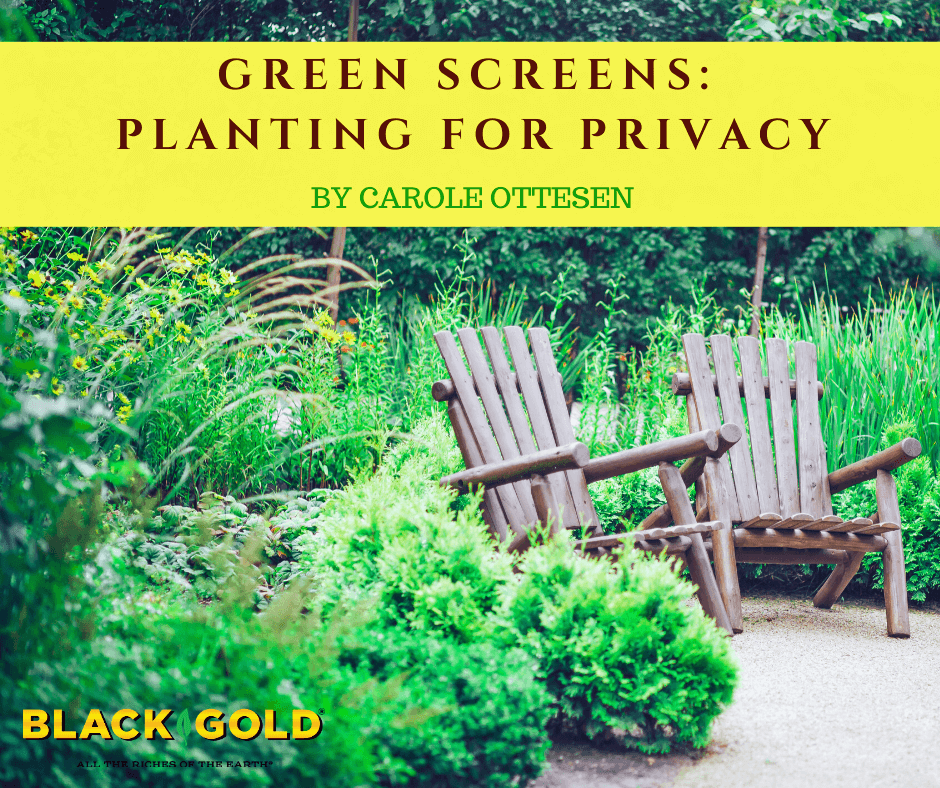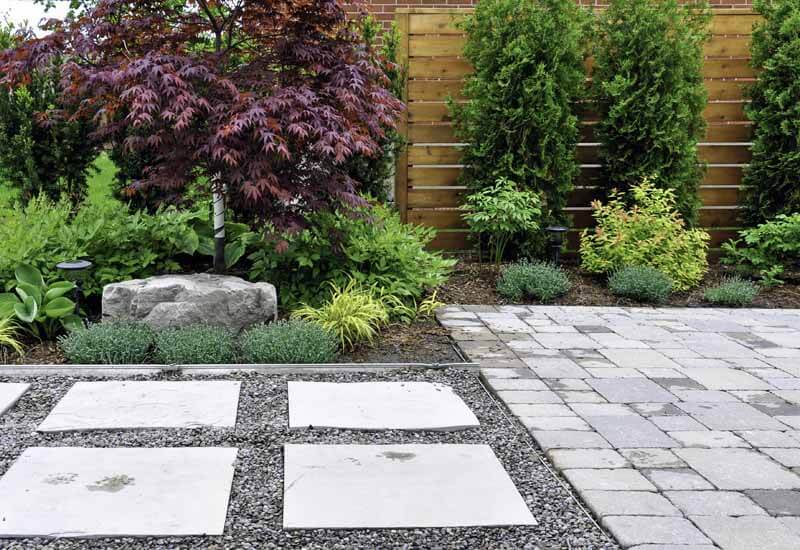
Using plants as screening is the prettiest way to block an unsightly view, demarcate space, channel traffic, or form the walls of an intimate outdoor room. A green screen can be anything from a single eye-stopping specimen to a uniform hedge, to a mixture of evergreen and flowering shrubs, to a vine-adorned fence. The type of plant that does the screening influences the overall personality of a garden as well as the amount of labor required to maintain it.
Ascending Evergreens

Often, the first plants that spring to mind for screening are three evergreens: Leyland cypress (Cupressus x leylandii, USDA Hardiness Zones 6-9), Japanese cedar (Cryptomeria japonica, Zones 6-8), and arborvitae (Thuja occidentalis, Zones 2-7). Each has a formal aspect and grows at warp speed; Leyland cypress tops out at 75 feet, Japanese cedar at about 50 feet, and arborvitae at 40 feet. Appealing as immediate gratification is, very tall plants can change patterns of light and shade, be difficult to prune, and, worse, grow out of proportion with the rest of a garden. For this reason, gardeners seeking a more manageable evergreen screen have more compact varieties of these trees from which to choose. North Pole® arborvitae has a narrow, conical habit and tops out at 15 feet, and Rein’s Dense Jade Japanese cedar is a choice variety that reaches 25 feet and has very dense growth.
Hedging Plants

Another traditional hedge plant is Skip laurel (Prunus laurocerasus ‘Schipkaensis’, Zones 6-9). It grows moderately fast, is dark green and dense, thrives just about anywhere, tolerates pollution and drought, takes pruning, and reaches about 12 feet. Unfortunately, deer love it.
Deer won’t bother spicily aromatic dwarf bayberry (Myrica cerifera, Zones 7-9), an evergreen that can eventually reach 10 to 15 feet but is generally much shorter. Its loose habit is casual, but for a more formal look, it takes well to shearing. Growing in wet or sandy soils, sun or shade, it isn’t bothered by salt spray or high winds and is ideal for seaside gardens. Northern bayberry (Myrica pensylvanica, Zones 3-7) is equally tolerant of tough growing conditions but is hardier and shorter, reaching between 5 to 10 feet.

A uniform clipped hedge is at home in a formal garden. Informal gardens allow for looser, more textured shrubs, such as the deep evergreen Prague viburnum (Viburnum x pragense, Zones 5-8). It will reach 8 feet tall by 6 feet wide quickly in the sun or part shade. It grows in full shade but won’t produce the fragrant, creamy white May flowers that are followed by showy black berries. The equally informal All that Glows® Arrowwood (Viburnum dentatum) is a pleasing deciduous viburnum that is tough and creates a fine screen. It takes well to shearing, has glossy leaves, and white flower clusters in late spring followed by clusters of deep blue berries that remain attractive into fall.
Screening Grasses

Informal gardens also allow for out-of-the-box thinking. How about a screen of ornamental grasses? Drought-tolerant, deer-resistant switchgrass (Panicum virgatum) is a tall, airy, native and some cultivars can reach up to 6 feet or more. The award-winning ‘Northwind’ (Panicum virgatum ‘Northwind,’ Zones 4-9) is vertical with olive-green blades and soft panicles that top out at 6 feet. It grows quickly in a single season. Another grass with a vertical appeal is the classic Karl Foerster Feather Reed Grass (Calamagrostis x acutiflora ‘Karl Foerster’), which reaches 4 to 6 feet. It’s upright green panicles age to warm tan by fall and remain attractive through winter.
Or how about grasses and shrubs in combination? Deer-resistant blue fountain or clumping bamboo (Fargesia nitida, Zones 5-8) reaches 10 feet tall or more. Clumps are dense, but the thin. Erect canes have a linear appearance that contrasts handsomely with bold, broadleaf evergreens in the foreground, such as Beale’s mahonia (Mahonia bealei, Zones 6-9)–a deep green shrub with prickly evergreen leaves that grows up to 10 feet tall and nearly as wide. Another complement would be Oregon grape holly (Mahonia aquifolium, Zones 6-8), which grows to 6 feet or slightly more and spreads to 5 feet wide. Fragrant yellow flowers bloom in the earliest spring. (Click here to read more about Oregon grape holly.)
Mixed Screens

Alone, evergreen Sky Pencil holly (Ilex crenata ‘Sky Pencil’, Zones 5-8) is ideal for a medium green screen in a narrow area. It reaches 10 feet, but stays 3 feet wide and under, grows in the sun or shade, isn’t fussy about soil, and needs no trimming. It is sensational when alternated in a hedge with just about any shorter flowering shrub. One choice might be deciduous flowering quince (Chaenomeles speciosa, Zones 5-8). Quince grows to about 6’ tall and bears pink, red, or white early-spring flowers, followed by tart fruits that can be used in jams and jellies. Its thorns deter deer, but there is a thornless and fruitless variety called Double Take Orange™ ( aka. Double Take Orange Storm), which has double flowers of deepest orange that make it well worth growing.
Privatizing Climbers for Fences

Sometimes, for reasons of space and time, only a fence will do. Espaliered trees or shrubs like apples, pyracantha, and camellias (Camellia species, zones 7-9), or a woody vine, like climbing hydrangea (Hydrangea anomala subsp. petiolaris, Zones 5-9), are great choices for added fence or green wall screening that goes a long way to improving the view.

